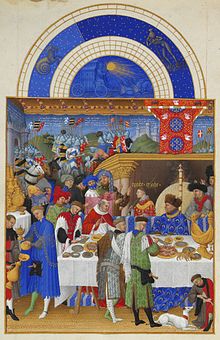January: Difference between revisions
rvv: I'm reverting blatant vandalism by you |
No edit summary |
||
| Line 9: | Line 9: | ||
Traditionally, the original [[Roman calendar]] consisted of 10 months of 304 days, 61 days of winter being considered a monthless period. Around [[713 BC]], the semi-mythical successor of [[Romulus]], King [[Numa Pompilius]], is supposed to have added the months of January and [[February]], allowing the calendar to equal a standard lunar year (355 days). |
Traditionally, the original [[Roman calendar]] consisted of 10 months of 304 days, 61 days of winter being considered a monthless period. Around [[713 BC]], the semi-mythical successor of [[Romulus]], King [[Numa Pompilius]], is supposed to have added the months of January and [[February]], allowing the calendar to equal a standard lunar year (355 days). |
||
The first day of the month is known as [[New Year's Day]]. Although [[March]] was originally the first month in the old Roman Calendar, January assumed that position beginning in [[153 BC]] when the two [[consuls]], for whom the years were named, began to be chosen on [[January 1]]. In |
The first day of the month is known as [[New Year's Day]]. Although [[March]] was originally the first month in the old Roman Calendar, January assumed that position beginning in [[153 BC]] when the two [[consuls]], for whom the years were named, began to be chosen on [[January 1]]. In [[525]], New Year's Day was set at [[March 25]] by [[Dionysius Exiguus]] to commemorate the [[Annunciation]] of [[Jesus]]. Various Christian feast dates were used for the [[New Year]] in [[Europe]] in the [[Middle Ages]], however, mediaeval calendars were often displayed in the Roman fashion of twelve columns from January to [[December]]. Beginning in the [[15th century]], European countries began officially making [[January 1]] the start of the New Year once again — sometimes called ''Circumcision Style'' because this was the date of the [[Feast of the Circumcision]], being the 8th day from [[December 25]]. |
||
{{wiktionary}} |
{{wiktionary}} |
||
Revision as of 23:59, 25 July 2006
Template:JanuaryCalendar January is the first month of the year and one of seven Gregorian months with the length of 31 days.
January begins (astrologically) with the sun in the sign of Capricorn and ends in the sign of Aquarius. Astronomically speaking, the sun begins in the constellation of Sagittarius and ends in the constellation of Capricornus.
January is named for Janus (Ianuarius), the god of the doorway and beginnings in Roman mythology.
See:- Months in various calendars
Traditionally, the original Roman calendar consisted of 10 months of 304 days, 61 days of winter being considered a monthless period. Around 713 BC, the semi-mythical successor of Romulus, King Numa Pompilius, is supposed to have added the months of January and February, allowing the calendar to equal a standard lunar year (355 days).
The first day of the month is known as New Year's Day. Although March was originally the first month in the old Roman Calendar, January assumed that position beginning in 153 BC when the two consuls, for whom the years were named, began to be chosen on January 1. In 525, New Year's Day was set at March 25 by Dionysius Exiguus to commemorate the Annunciation of Jesus. Various Christian feast dates were used for the New Year in Europe in the Middle Ages, however, mediaeval calendars were often displayed in the Roman fashion of twelve columns from January to December. Beginning in the 15th century, European countries began officially making January 1 the start of the New Year once again — sometimes called Circumcision Style because this was the date of the Feast of the Circumcision, being the 8th day from December 25.
Historical names for January include its original Roman designation, Ianuarius, the Saxon term Wulf-monath (meaning wolf month) and Charlemagne's designation Wintarmanoth (winter / cold month). In Finnish, the month is called tammikuu, meaning month of the oak. This month is in Czech called leden, meaning ice month.

The first Monday in January is known as Handsel Monday in Scotland and northern England. In England, the agricultural year began with Plough Sunday on the Sunday after Epiphany.
The Coming of Age day in Japan is the second Monday of January, for those becoming 20 years old in the new calendar year. It is a national holiday. The day has been celebrated since 1948, but fell on January 15 until 1999, when it was moved by the Japanese government in an attempt to lift the economy by making more holidays consecutive.
In the pagan wheel of the year, January ends at or near to Imbolc in the northern hemisphere and Lughnasadh in the southern hemisphere.
January Events
Historical Firsts
- 7 First American presidental election, 1789
- 9 Seeing eye dogs first trained to guide the blind in Nashville,Tennessee, 1929
- 10 First great oil discovery in Texas, 1901
- First United Nations General Assembly met in London, 1946
- 21 Nautilus, first atomic submarine launched, 1954
- 23 Elizabeth Blackwell, first modern woman physician, graduated from Geneva Medical School of western New York, 1849
- 24 gold first discovered in California, 1848
- 27 [[Canadian Great Western Railway first opened, 1854
Historical Events
Holidays
Births
Deaths
Trivia
- January in the Northern Hemisphere is the seasonal equivalent to July in the Southern Hemisphere and vise versa.
- Leap years exempted, January always begins on the same day as October.
- January's birthstone is garnet.
- January's flower is the carnation or snowdrop.
- The Chinese floral emblem of January is the plum blossom
